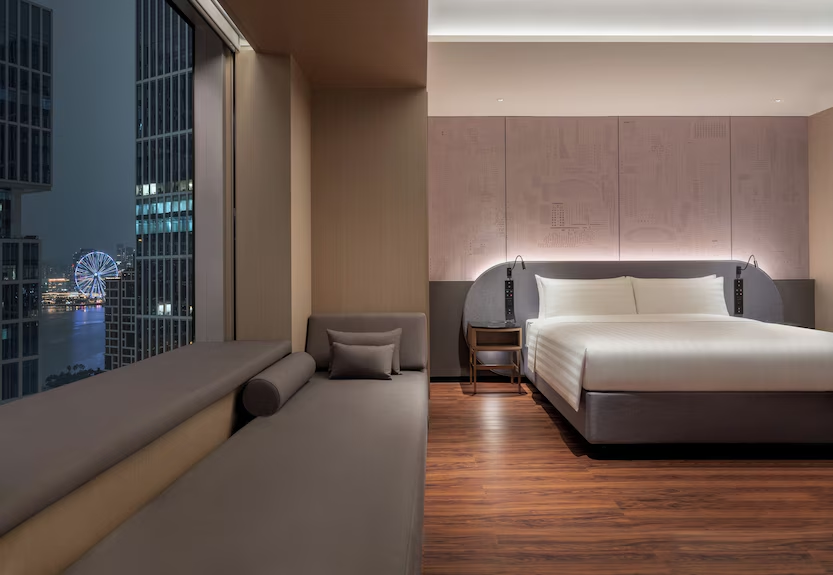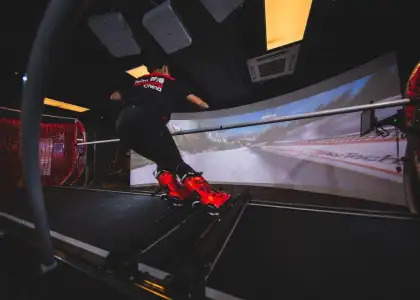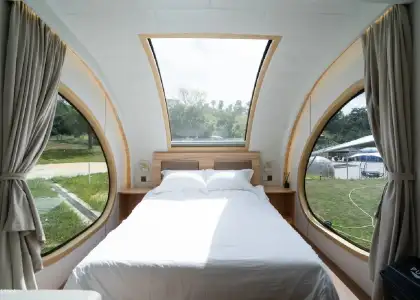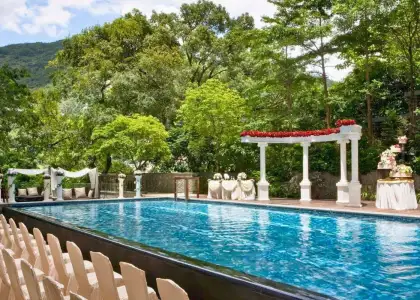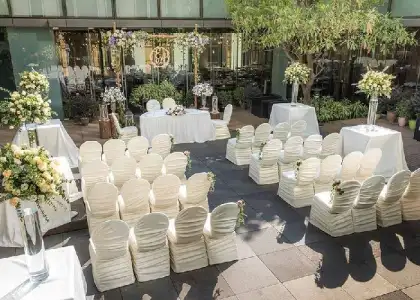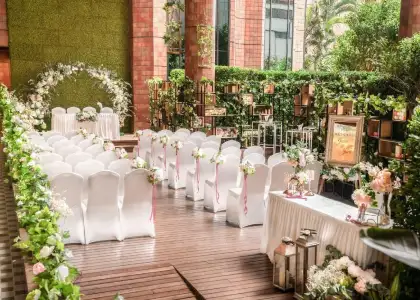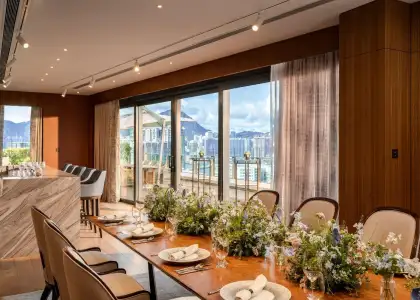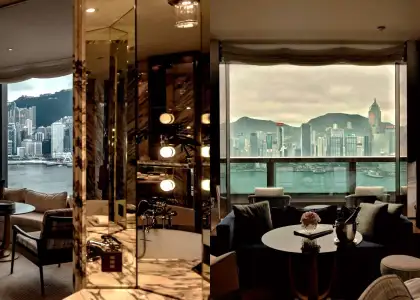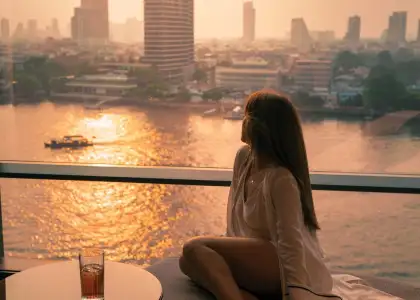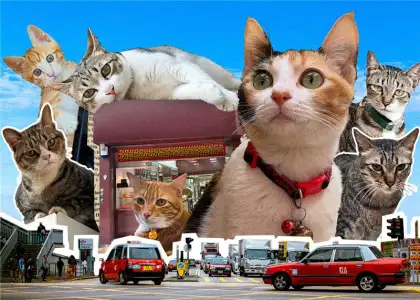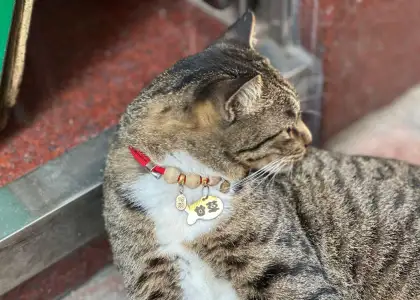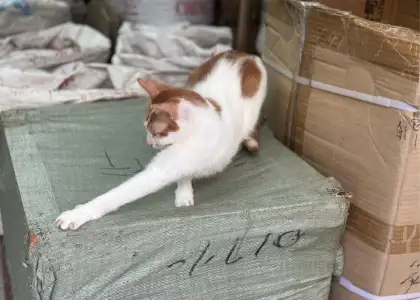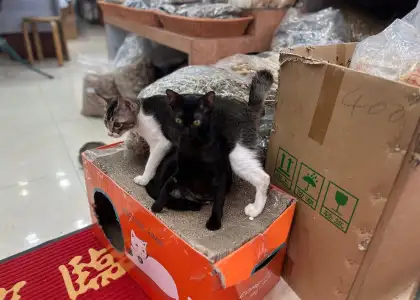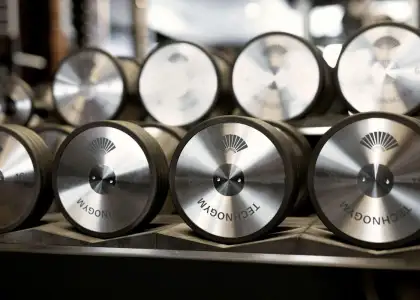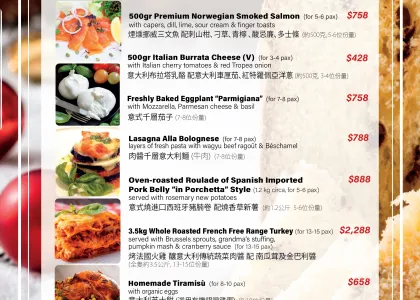The British Artist and Story Behind Sai Ying Pun’s Eye-Popping Mural

Take the MTR to Sai Ying Pun Station, follow the slight gradient of the cavernous hallway directing to Exit B, and arrive at the room holding four elevators travelling up to First Street and Second Street.
Circling the four 12-foot-high walls of the room stands one of the MTR’s, and Hong Kong’s, most illustrious art pieces, designed to draw viewers into the long street scenes of Sai Ying Pun above and encapsulate the frenetic, feverish, and frenzied nature of the Cantonese-dominant neighbourhood.
Twelve acrylic floor-to-ceiling art pieces cover the walls of the room, made with fiber-reinforced plastic panels painted in acrylic. Faces of Sai Ying Pun, tea shops, dai pai dongs, hairdressers, markets, fruit stalls, street corners, skyscrapers, and dingy apartment buildings are featured in the mural, with exaggerated perspectives and literally popping out of frame.
The larger-than-life bas-relief mural remains a centrepiece of the busy Exit B. Locals on a morning rush hour and an evening return from work stop every so often to admire the intricate details and expression of Sai Ying Pun. Little is known, or made publicized, of the British-born artist, Louise Soloway Chan, 59, whose art piece has been studied, scrutinized, and photographed for years, but with extremely limited publicity of herself.

Construction began on the western extension to Kennedy Town on the Island Line in 2009. New stations in Sheung Wan, Sai Ying Pun, HKU, and Kennedy Town were planned for the extension, with passenger services opening December 2014.
During the planning stages for the Sai Ying Pun station in 2011, the MTR Corporation (MTRC) began fielding submissions and applications for six distinct artworks in the underground passenger way to manifest the captivating Cantonese culture of street-level Sai Ying Pun.
A friend reached out to Louise, already a seasoned local artist specializing in large-scale murals, in 2011 persuading her to throw her hat in the ring for the competition.
Louise had done several commissions previously for Hong Kong corporations, including a large-scale mural of the Chep Lap Kok airport detailing the scenes of the preliminary stages of construction in 1998.
“You should think of doing something similar to what you did in Chep Lap Kok,” Louise recounted on what her friend told her, “So I thought whilst the station was being built, I could just do one image of how the station was being built.”
Louise wrote to a general email address of the MTR and got a quick reply. The MTR were interested in her previous work and creating a bas-relief artwork exploring the minutiae of Sai Ying Pun’s traditional environment.
“They called me in and showed the architects plan, engineer sketches, and the massive scale of the art project. ‘That looked pretty enormous, my studio doors aren’t that big enough’ I remember thinking!”
“I was talking to Ray (Louise’s husband), saying I can’t possibly do [this project], it’s impossible, but he really did help [motivate] me. I had to work completely differently; it was larger than anything I’ve done [before].”
“You’re gonna have to just think differently, and you’re going to have to partly outsource and look for a factory.”
Louise then agreed to partly outsource the project. Her quest to look for a factory to manage the magnitude of the project began in Hong Kong, and then south China. In late 2011, she enlisted the help of a factory located 100-kilometre north of her home in Pokfulam in Dongguan, China to begin with the project.


Research for the artwork was simple, according to Louise. A self-described visual diarist, Louise traced Sai Ying Pun’s horizontal streets up and down for months in all four seasons, collecting upwards of 30,000 pictures from her iPhone of shopfronts, temples, cafes, fish and meat markets, vegetable stalls, apartment buildings, and construction.
When Louise had a creative block, which was often, she mentioned that she would venture out to the neighbourhood to soak up the atmosphere and snap a couple hundred pictures.
Louise devised the pieces’ capturing a moment in time of the area's shops and street scenes. The twelve panels consist of six storefront scenes and six street scenes.
Each panel is framed in a compass-point perspective, with each direction of Sai Ying Pun exposed in the art piece: North down to the harbourfront, South up the hilly roads facing the Peak, East towards Central and Soho, and West towards Western District.
Each panel depicts a different season.
The “northern” panel is of the escalator on Centre Street facing Caine Road. Painted in Christmas in Hong Kong’s mild 2011 winter, characters wear puffer jackets to ward off the cold and gold-covered pots of red poinsettias frame the storefronts opposite the ongoing construction.
The “east” panel captures a post-typhoon summer scene of a fallen banyan tree and shrubbery blocking Eastern Street and facing east towards IFC. A handful of damaged blown-out umbrellas are stuffed into a dustbin and overflowing drainage water litters the street.
The “southern” panel is based on events seen by Louise during Mid-Autumn Festival, with traditional fish lanterns and locals shopping for new shoes and bags lining the sidewalks.
The “west” is of a Lunar New Year spring scene on Queens Road West, symbolized by the dominating orange tree in the foreground and the side of a passing tram decorated with snake symbols, in celebration of the Year of the Snake when Louise captured the scene in February 2011.




A traditional dai pai dong, retro 1980s hairdressers, tea shop, worshipping-materials store, a fruit stall, and outdoors fishmongers are also featured in the 2.4x2.2-metre art piece. The details of the flopping fish, tea bags dangling from counters, blubber fish lanterns, the knobs on the durian fruit, and weaves of local Hong Kong ladies typify Louise’s attention to detail of Sai Ying Pun’s ingrained identity.
After the successful submission with the MTR in November 2011, Louise began her then-weekly trips to her Dongguan studio to construct the epic mural. Folders of pictures on her Mac turned into rough sketches, which turned into detailed coloured oil-paintings, brown clay structures, and finally to FRP (fiber reinforced plastic) boards that were casted, painted, and primed.
“I used to go there for three nights a week [at a time] to work on the piece,” Louise said, adding that her weekends were spent with her husband, Ray, and son, Jesse, in Hong Kong. She stayed in a hotel close to the factory during the night and enlisted the help of the English-speaking factory owners and Google Translate to mediate conversation with her Chinese art assistants.
Contrary to the location of the art piece, not every image in the mural is inspired nor replicated from Louise’s on-the-ground research. “They’re sort of a mishmash,” Louise said, referring to which storefronts and street scenes are local to Sai Ying Pun and areas further away. The Sophisticuts hairdresser panel is a scene from Wan Chai’s waving-cat and perm-heavy hairdressers, the smoking fishmonger in the market scene is inspired by a popular figure opposite Shau Kei Wan’s Elsa High School, and the typhoon scene from the destruction of Pokfulam following Typhoon Vincente in 2012.


The project involved a year of submissions and designs with the MTRC in 2011, a following year of consultation with architects and engineers, and a continuous four-and-a-half years of work on the piece itself, until completion in January 2015.
Gaps in the project arose when a delay of 18 months occurred in the construction of the Sai Ying Pun station, due to the technically challenged work of installing stations in the high-angled sloped neighbourhood. “The difficulty for [the art team] was that we had a whole production team. All the delays meant that we had to hang around, accruing costs for paying labor,” Ray told The Beat Asia.

“In the factory, my panic was that because all the work used modelling clay, the clay must stay wet to be malleable, otherwise it cracks,” Louise recounted in horror, “it had to be watered during the construction delays. Over Chinese New Year in 2014, factory workers in Dongguan were ordered to travel to the site to “‘water”’ the clay every day to prevent cracks. During one prolonged period of inactivity, mushrooms began to grow between the cracks.
The art piece opened in two phases, due to the delayed opening of the stations Exit C and broken goods elevator. Half of the art piece was installed in January 2015, with the latter in January 2017 when Eexit C opened. Louise and Ray, alongside MTR workers, pulled an all-nighter to bring the artwork from Dongguan to Sai Ying Pun and install the panels.


Uncharacteristically, Louise has a resolute attitude towards remaining anonymous and avoiding the awkward fame that often comes with being an artist. “I hate the whole artist thing with people saying, ‘you’ve got to be polite to the artist.’”
In our interview with The Beat Asia, Louise recounted the many sleepless nights fearing backlash over residents’ opposition towards a creation of an art piece by a British artist, not a local Cantonese one. After all, her name on the plaque to the far right of the bas-relief wall panels reads Louise Soloway Chan.
“When you do art for the public, it becomes public domain. When I go down [to visit the art piece], I really like seeing, genuinely, that people are enjoying it.”
“It’s kind of odd when I go down there, because you’d think like it’s a huge part of my life, but it’s just there.”
Louise says that people still connect to her on a weekly basis with texts and calls congratulating her on the art piece, seven years since the first panel was installed.


Subscribe to The Beat's newsletter to receive compelling, curated content straight to your inbox! You can also create an account with us for free to start bookmarking articles for later reading.




















